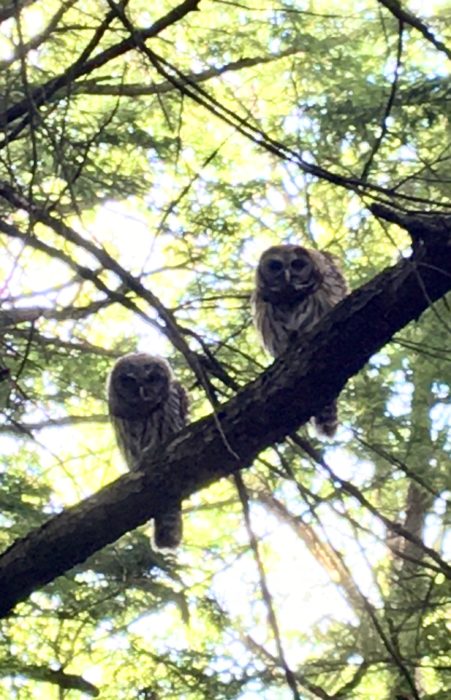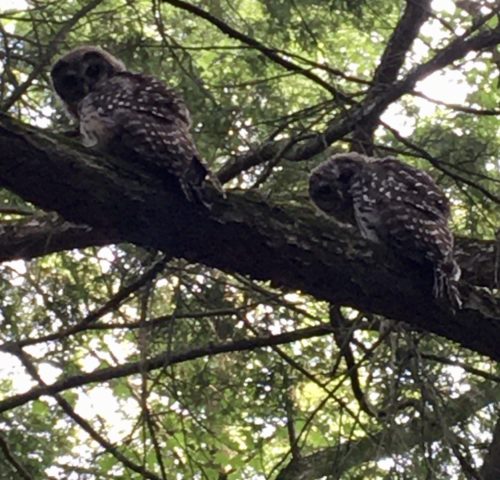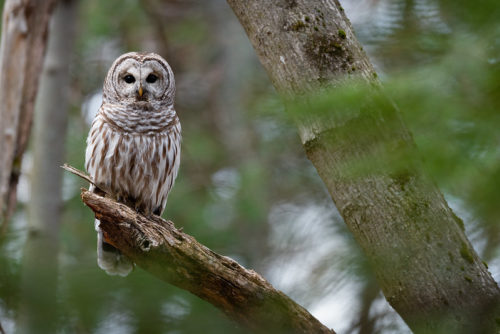A Summer of Owls

They’re gone now, and have been for a while. But through much of the summer, Emily and I kept encountering two owls in the park where we walk our dog. Much to our delight, we watched them grow up.
An owl’s territory is usually at least twice the size, but this 100-acre forest offers good owl habitat, with mature white and red pines, hemlocks, oaks, maples, hickories, and more. The old trees have cavities that owls use for nests. To the south, cliffs overlook a bay, and to the west, stone ledges slope steeply down to Lake Champlain. Even though the park gets a lot of use and has suburban neighborhoods on two sides, it supports an array of wildlife. Over the years—in addition to crows, squirrels, rabbits, and chipmunks—I’ve seen foxes, the occasional deer, two moose (amazing!), a mink, an ermine, and fishers. Some well-hidden wildlife cams have even caught bobcats there.
The owls were a blessing, and any and all blessings were welcome, because this was the summer of 2020 and of COVID. How can I begin to say what that meant? Everything uncertain, the world and country in turmoil, the future a gray unknown. That gray was shot through with dread and promise—and still is.
Despite the uncertainty—and weirdly, because of it, too—life felt entirely predictable and stunted. Though it isn’t really true, it has seemed as if my life is tethered to a three-by-five-foot table in a single room, as I’ve taught, had phone and Zoom meetings, done research, and written (emails, shared docs, and—thank goodness—even articles). There’s good sense in the notion that, in addition to home and a workplace, we need a “third place,” somewhere we can go regularly and be known. Mine is a coffee shop, where I frequently read, write, and prepare classes, but I haven’t been there since mid-March. What happens when you don’t have a second place, work, much less a third? Life contracts.
The owls dropped into my life as if from a larger mysterious region, one untouched by the pandemic. We were in the same forest, but our experiences of that shared space were different to the core. Theirs is a world of air and trees, of dusk and darkness, and we met at an edge where our distinct realities overlapped. Though owls are no wilder than crows or foxes, they seem stranger, more surprising. In some traditions owls convey wisdom, in others they foretell death or change. Either way, they’re different than other flying things.
Sometimes we saw them, sometimes not. Sometimes we found them in one part of the park, sometimes another. The element of chance was part of the pleasure. One of the things I have missed about being out and about in the world is that I might see someone I know. Or not. Along with wonder and delight, the owls brought anticipation back into my life when I really needed it. I looked forward not just to seeing them, but to the possibility of seeing them.

We’ve given quirky collective nouns to many groups of animals and birds, even those who are largely solitary, like owls. Pack, school, gaggle, skulk, murder—we tend to use only a few of them, but they’re fun for word lovers like me. The most common one for owls is parliament, as if somewhere deep in the forest large groups of owls convene and deliberate on matters of state.
This was a parliament of northern barred owls. The two we saw were juveniles. The other members of this mini-parliament, their parents, didn’t appear, though we sometimes heard their fluid melancholy hoots in the distance: Who-cooks-for-you, who-cooks-for-you-all. There’s a second collective noun for owls, a stare, and the word suited these two to a t: They stared down at us as with their big dark eyes as we stared up at them.
Early in the spring, we had spotted an adult owl a couple of times—an impressive fleeting vision of motion and wing. Though an adult barred owl is 16 to 20 inches long, is shaped like a barrel, and has a wingspan of 39 to 44 inches, it moves silently, sweeping along flyways among the trees. Soft feathers serve as baffles and ensure stealth. Unless you’re looking in just the right spot, you can miss a flying owl altogether. I know I have at least a couple of times—and many more than I will ever know. The owl’s there, then not there.
We heard from birders—hardy folk who appear to be born with patience, binoculars or cameras strung around their necks, and the fortitude to sit still in the wet cold or in the middle of a cloud of blackflies—that two owlets had hatched. Some weeks later, we heard a high-pitched, rising raspy sound—somewhere between a cat’s hiss and a rusty whistle (click here and scroll down to Juvenile Calls to hear it). We looked up and spotted one, then two owls sitting on separate branches about twenty feet up in adjacent white pines. It was thrilling. Emily crept closer to take pictures with her less-than-up-to-date iPhone. You can picture me doing a quick happy dance after we walked away.
As the summer progressed, we saw them as often as three times a week. We frequently ate dinner at nine o’clock because we had stayed in the park to watch the owls until it was too dark to see them anymore.
We found the owls, who often stayed near each other, in one of four ways. First was dumb luck, when we’d round a corner and startle one on the ground or flush one from its perch. Second was when songbirds, sometimes joined by a red squirrel, gathered in the branches near them and made a racket. This behavior, called mobbing, seems counterintuitive. Why get close to a dangerous predator and advertise your presence? Why not just tuck yourself in a safe spot and keep an eye on the owl? Third was when a small band of humans would come to a standstill on the trail and gaze fixedly up into the trees. A quiet, polite form of mobbing? We weren’t the only ones thrilled by this pair. We all adjusted our masks and helped one another locate the owls, though it’s awkward to point something out when you’re six feet apart. See that big hemlock trunk? A little more to the left. Yeah, that one. Look up about four branches. Fourth and most frequent was when we heard the juvenile hiss. We’d scan the trees, listen, and creep toward the sound until we found one or both of them.
The owls grew and developed fast. When we first saw them, they were no longer fluffy owlets because once barred owls fledge at about six weeks, they look a lot like adults. They did what growing owls must do: observe. Mostly, at least when we were around, they sat on a branch and took everything in. To become proper owls, they had a lot of learning to do in a few months. This may explain why we got to see them so often and, because their territory is on the small side, were more likely to cross paths. One of the delightful things was that we were interested in each other; they sized us up as we watched them—though I’m sure I’d have felt differently about being inspected by an owl if I were a smaller mammal. In June and early July, they bobbed and weaved their heads and bodies as they watched us—hardly the serious owlish behavior you’d expect. This is pure speculation, but I think they were testing and exercising their amazing powers of hearing and binocular vision, using us as focal points.
We often saw them where the trees are tall and the undergrowth sparse, excellent places to practice flying and hunting. They’d fly from perch to perch, from perch to ground, and from ground to perch. But most of the time, they occupied their airy stations and intermittently hissed. At us? To let their parents know where they were? Begging for dinner to be delivered?
This year, dinner probably included plenty of chipmunks. Last summer and fall produced a healthy crop of mast—hard tree nuts like acorns, beechnuts, and butternuts—that fueled the chipmunks as they wintered over, and enabled them to give birth to abundant litters. In Vermont this spring and early summer, chipmunks were everywhere and even made the news. But by late summer, the chipmunks grew scarcer—many, no doubt, having vanished down the gullets of the owls and other predators.
After a trip to Maine to visit my father and stepmother in mid-August, I took my first walk in the park and wondered if the owls would still be there. After four or five months, the parents stop feeding the juveniles, and the young ones have to leave to find their own home territories. The time had probably come. This must be a difficult and dangerous transition for an owl—to find a new stretch of forest that will sustain it—especially in a time of habitat fragmentation and loss. But as we headed down toward the lakeshore, we spotted a fellow dog-walker who had stopped on the trail and was looking into the trees. A good sign! About twenty feet away, the owl sat still and alert. It swiveled its head when a sound got its attention but only glanced down at us occasionally. No more bobbing and weaving, no more stare.

Photo Credit: Kyle Tansley
And then, no more owls. Over the next few weeks, we kept listening and scanning the trees, but heard no hiss, spotted no familiar camouflaged shape on any branch. The owls had gone. It’s the right order of things, but I still miss their particular presences and wonder how they’re doing. Add it all up—twenty minutes, half an hour, fifteen minutes—and we didn’t spend that much time watching them, seven or eight hours total maybe. But the time we spent watching the owls dilated, the way pupils dilate when you gaze at a brilliant dark pink azalea in full bloom. The owls filled and stretched the summer and allowed me to glimpse a world that exists alongside and outside the limits of mine. Because of them, I experience forests a little differently now. Is this a place where a young owl might make a home? And if I hear an owl call, I wonder if it could be one of “ours.”
Thanks to Kyle Tansley, a wildlife photographer who lives in Burlington, Vermont. He has been watching this particular owl for over a year. You can find more of his photographs at Kyle Tansley Photography.
